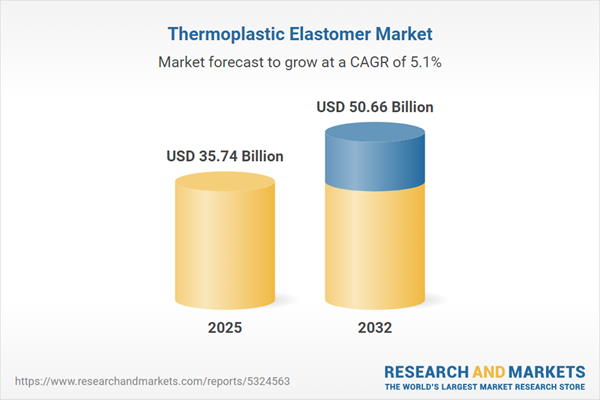Speak directly to the analyst to clarify any post sales queries you may have.
Thermoplastic elastomers are becoming a material of choice for senior executives seeking sustainable, flexible solutions to meet rising regulatory and market demands. These polymers enable organizations to realign strategies rapidly and maintain operational flexibility as the business environment evolves.
Market Snapshot: Thermoplastic Elastomer Industry Overview
The global thermoplastic elastomer market is valued at USD 34.10 billion in 2024 with a CAGR of 5.07%. Widespread changes in regulatory requirements and a heightened corporate focus on sustainability continue to shape materials selection across sectors. Senior leaders are embracing thermoplastic elastomers to provide adaptable solutions, de-risk supply chains, and ensure ongoing business continuity under shifting compliance mandates. These materials facilitate integrated production methods and enable companies to realign operations as market needs shift, supporting supply assurance and competitive positioning in complex regulatory settings.
Scope & Segmentation: Thermoplastic Elastomer Market
Comprehensive segmentation ensures effective investment targeting and compliance, equipping leaders to engineer high-performance, tailored solutions for priority applications. Strategic segmentation supports more responsive planning across research, procurement, and manufacturing operations, helping organizations remain agile and resilient.
- Product Types: Copolyester elastomers, styrenic block copolymers (including styrene butadiene styrene and styrene isoprene styrene), thermoplastic polyurethanes (polycaprolactone, polyester, polyether), and thermoplastic vulcanizates, all tailored for diverse technical and regulatory needs.
- Manufacturing Processes: 3D printing, blow molding, calendering, extrusion, injection molding; these support rapid prototyping and scalable production for critical sectors such as healthcare, automotive, and electronics, while enabling faster market responsiveness.
- Form Factors: Films, pellets, powders, and sheets, providing the adaptability required to harmonize research, development, and inventory management with evolving product portfolios.
- Applications: Adhesives, sealants, construction goods, automotive parts, cable insulation, electronics, medical devices, footwear, and packaging, addressing commercial objectives in core sectors.
- Distribution Channels: Direct supply agreements, specialist distributors, and digital procurement platforms enhance procurement agility and support operational resilience through dynamic supply shifts.
- Geographic Coverage: Americas, Europe, Middle East & Africa, Asia-Pacific; regional strategies must account for specific regulatory drivers, buyer expectations, and supplier ecosystems, helping businesses localize their approach for each market.
- Industry Coverage: Key firms include Arkema S.A., Asahi Kasei Corporation, Covestro AG, Lubrizol Corporation, and Dow Chemical Company—leaders who underpin sector advancements and secure continuous inflow for manufacturing, health, and technology applications.
Key Takeaways for Senior Decision-Makers
- Switching to bio-based and recyclable thermoplastic elastomers supports long-term sustainability and aligns with rising expectations for circular value chains and product stewardship.
- Adopting advanced manufacturing techniques, such as extrusion and additive manufacturing, drives faster product launches and addresses technical shifts in high-growth markets.
- A regionally tailored approach is essential; companies in the Americas are advancing mobility and healthcare solutions, Europe prioritizes environmental compliance, and Asia-Pacific expands in packaging and electronics demand.
- Strengthening supply networks through near-shoring and digitalized inventory supports robust procurement and mitigates disruptions amid fluctuating global trade or regulatory events.
- Integrating advanced material tracking and prioritizing sustainable input selection delivers improved compliance management and operational transparency for distributed operations.
Tariff Impact: Navigating Regulatory Shifts
Impending U.S. tariffs in 2025 will prompt organizations to reassess sourcing and production strategies. Emphasizing domestic production, expanding supplier bases, and optimizing inventory systems will be necessary to manage expenses and maintain steady material flow throughout transitions in policy or market dynamics.
Methodology & Data Sources
This analysis is based on public-sector research, regulatory disclosures, intellectual property analysis, executive interviews, and industry-focused surveys. Rigorous cross-validation was conducted to provide actionable, reliable intelligence specific to the thermoplastic elastomer sector.
Why This Report Matters
- Enables proactive risk reduction in sourcing and procurement by delivering in-depth evaluations of supply landscapes at global and regional levels.
- Supports scenario-driven strategic planning, empowering decision-makers to address evolving compliance requirements and seize growth alternatives with clarity.
- Delivers proven best practices to help organizations assure business continuity and respond decisively to market and policy shifts.
Conclusion
Thermoplastic elastomers equip leaders to respond to legal and sustainability requirements with agility and resourcefulness. Strategic insight from this report helps organizations fine-tune operational strategies and enhance competitive resilience in an evolving marketplace.
Additional Product Information:
- Purchase of this report includes 1 year online access with quarterly updates.
- This report can be updated on request. Please contact our Customer Experience team using the Ask a Question widget on our website.
Table of Contents
3. Executive Summary
4. Market Overview
7. Cumulative Impact of Artificial Intelligence 2025
List of Figures
Companies Mentioned
The companies profiled in this Thermoplastic Elastomer market report include:- Arkema S.A.
- Asahi Kasei Corporation
- Aurora Plastics, LLC
- Avient Corporation
- BASF SE
- Biesterfeld AG
- Celanese Corporation
- China Petroleum & Chemical Corporation
- Covestro AG
- Omya International AG
- DuPont de Nemours, Inc.
- Elastron Kimya Sanayi ve Ticaret A.Ş.
- Evonik Industries AG
- Exxon Mobil Corporation
- Huntsman International LLC
- KRAIBURG TPE
- Kraton Corporation by DL Chemical Co., Ltd.
- LCY Chemical Corp.
- Lubrizol Corporation
- LyondellBasell Industries N.V.
- Mitsubishi Chemical Holdings Corporation
- Mitsui Chemicals, Inc.
- Moriroku Chemicals Company, Ltd.
- RTP Company
- Shin-Etsu Polymer Co., Ltd.
- SIBUR International GmbH
- Teknor Apex Company, Inc.
- The Dow Chemical Company
- TSRC Corporation
- Zeon Corporation
Table Information
| Report Attribute | Details |
|---|---|
| No. of Pages | 184 |
| Published | November 2025 |
| Forecast Period | 2025 - 2032 |
| Estimated Market Value ( USD | $ 35.74 Billion |
| Forecasted Market Value ( USD | $ 50.66 Billion |
| Compound Annual Growth Rate | 5.0% |
| Regions Covered | Global |
| No. of Companies Mentioned | 31 |









